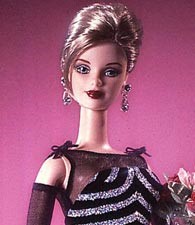It’s been more than 50 years since the blond-haired, blue-eyed, impossibly proportioned Barbie doll hit the market. She’s held many jobs, lived in many homes, driven several cars and weathered her share of criticism, but she remains an extremely popular toy.
The Creation of the Barbie Doll
The force behind Barbie was Ruth Handler, along with her husband Elliott, founded the company Mattel with Harold Matson during World War II. In 1956, the Handlers were traveling in Europe when Ruth got the inspiration for Barbie; she saw a doll modeled after an adult woman, so different from the baby dolls owned by most American little girls.
On March 9, 1959, Barbie, named after the Handlers’ daughter Barbara, debuted at the New York Toy Fair. Her boyfriend Ken was named after their son.
Sources in this Story
- PBS: Who Made America?: Innovators: Ruth Handler
- The Economist: Happy birthday, Barbie
- LiveScience: Voice of Reason: Research Debunks ‘Barbie Ideal’
- The Gainesville Sun: Designer creates Barbie’s dream house for doll’s 50th anniversary
- YouTube: Jonathan Adler Malibu Dream House Tour
Barbie’s Popularity
Barbie has spent the past 50 years as a commercial phenomenon, and is currently sold in 150 countries. According to The Economist, “Every second, three Barbies are sold around the world.”
Barbie has attracted her share of criticism; many feminists believe Barbie’s shape and curves set an unattainable standard for girls. However, Skeptical Inquirer managing editor Benjamin Radford refers to a University of Bath study that indicates that “because a girl plays with a Barbie doll does not mean she idolizes it or views it as a physical role model.” Radford goes on to say, “It seems that not a single survey, poll, or study has shown that girls actually want to look like Barbie dolls.”
Barbie and the other friends Mattel introduced in her line have had several careers, including an astronaut and rock star. However, Barbie kicked up another role-model controversy in 1992. Teen Talk Barbie appeared to embrace the “dumb blonde” stereotype with an electronic voice box that said, among other things, “Math class is tough.”
In response, a group calling itself the Barbie Liberation Organization swapped the voice boxes from several Teen Talk Barbies with those of Talking Duke G.I. Joe dolls (which originally said things like “Vengeance is mine!”) and then returned the dolls to store shelves. Perhaps to make up for the math remark, in February 2010, Mattel introduced the 125th career for Barbie: computer engineer.
Barbie on Amazon.com
- “Forever Barbie: The Unauthorized Biography of a Real Doll,” by M. G. Lord
- “Barbie: The Icon, the Image, the Ideal; an Analytical Interpretation of the Barbie Doll in Popular Culture,” by Kristin Noelle Weissman
The Rest of the Story
Ruth Handler resigned as Mattel’s president in 1973 when she was diagnosed with breast cancer. After a mastectomy, she created a line of breast prostheses. According to PBS, the “Nearly Me” line, “still produces and distributes breast replacements and post-mastectomy swimwear to customers internationally.” Handler died in 2002.
On March 9, 2009, Mattel marked Barbie’s birthday by releasing the 2009 Black-and-White Bathing Suit Barbie doll and hosting a party in a real-life Malibu Dreamhouse designed by decorator Jonathan Adler.
Barbie’s 50th year saw sales of the doll surge after years of decline, due in large part to Mattel’s legal victory over rival MGA Entertainment, the manufacturer of Bratz dolls. “Barbie is back,” said Mattel CEO Bob Eckert.
Explore everything that is Barbie at her official Web site.











